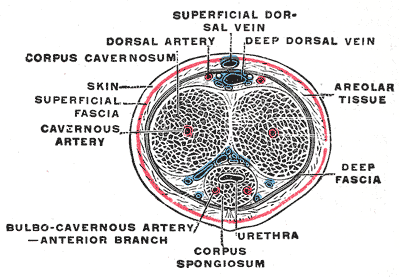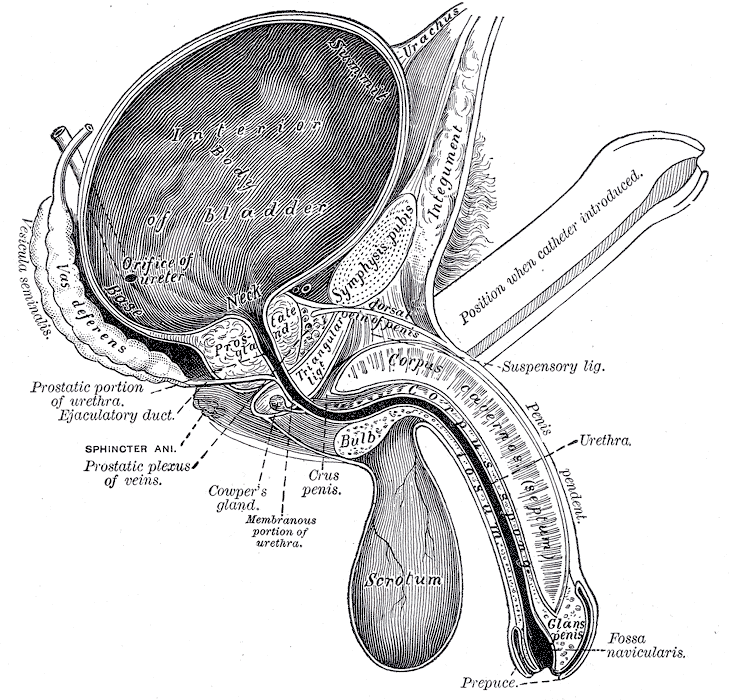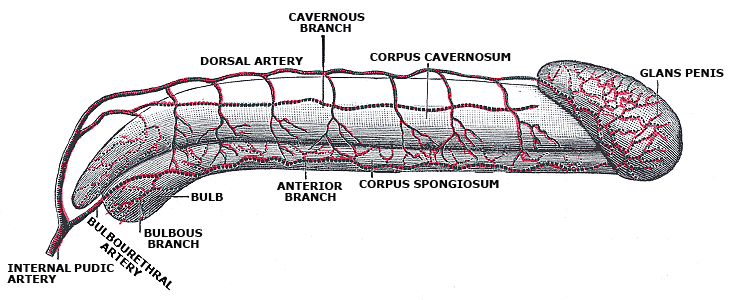Boner. Hard-on. Love muscle. None of these euphemisms help with dispelling misconceptions about penile anatomy. To understand how to get the most out of your dick you need to understand how your dick works. And that means understanding the anatomy of the penis.

Penile Anatomy
First things first: the human penis is not a muscle, nor does it contain any bones. It is a vascular organ — one that changes shape based on the amount of blood pumped into it. The bulk of the penis is composed of erectile tissues, these are spongy tissues that can expand in volume as more blood is pumped inside them. There are three of these erectile tissues, each running the length of the shaft: two larger corpus cavernosum on the left and right of the top side of the penis, and a smaller corpus spongiosum on the underside that extends out to form the glans (head/tip).
This provides the wider-than-taller cross-section of most erect penises, typically with a pronounced ridge on the underside where the corpus spongiosum is situated.
The urethra is a tube that runs through the middle of the corpus spongiosum and is responsible for transporting both urine and semen to the outside world. Urine is supplied to the urethra directly from the bladder, while semen enters a bit further down the pipe with a longer route that traces up past the prostate and then back down into the scrotum.
The whole assembly is then wrapped in a thin layer of skin, with an extra hood of foreskin extending past the glans to protect and lubricate that nerve-laden tissue. The surgical operation to remove the foreskin is called circumcision, and is performed for religious reasons amongst Jews and Muslims, and for aesthetic and traditional reasons in many North American families of other religions. The practice is controversial in many circles, as it removes some of the most sensitive tissue on the penis and was popularized beyond its historically religious practices as a deterrent to promiscuity.

Erectile Function
Blood is constantly pumping through the erectile tissues tissues, regardless of your state of arousal. When you are aroused, things start to change: the blood vessels flowing in dilate to increase the inflow rate, while the veins that drain out constrict to limit the outflow rate. The causes a backup of blood in the penis, increasing the pressure and causing the erectile tissues to expand in volume.
As the erectile tissues expand, the penis will increase in both length and girth, and given enough time and pressure will become stiff and firm to the touch. The foreskin will also pull back to a degree, exposing the glans for maximum stimulation during intercourse.
In essence, the human penis is a blood sponge inside a skin balloon.
Erections are held aloft by the suspensory ligament. This short band of tough connective tissue stretches from the pubic bone directly above the base of the penis to the fascia tissues that surround the erectile tissues. The length and tightness of the ligament varies from man to man, with some erections held high and close to the body, while others hang more pendulously.
There are surgeries to lengthen the suspensory ligament for men that have trouble moving their erections away from their body, though the surgery should always be done in consultation with a urologist (a doctor that specializes in urinary and sexual health). The surgery is also popular with porn stars, as it can increase the apparent size of the penis, but not the actual functional size.
Ejaculation is driven by a combination of organs. Sperm are stored ready for ejaculation in the vas deferens (tubes that transport sperm away from the testicles), and when they get the "go" signal from your brain the tubes contract to push the sperm up and away. The sperm pass by the seminal vesicles and prostate, where they pick up the lubricating and protecting transportation fluids that make up the bulk of semen volume. This is all expelled out through the penis via contractions of the muscles at the base of the penis.

Variations of the penis
Dicks come in all sorts of shapes and sizes, and there are a lot of factors that contribute to their eventual form.
Size is largely genetic, with both the mother and father contributing genes, as well as random genetic mutations driving different results. While a few genes have been identified as having some influence, the genetic markers that determine a man's penis size have not been studied in depth. There is also some evidence that prenatal hormones can contribute to size, though only in that unusually low testosterone levels in the womb pointed towards smaller penis size in infants, with no indication that above-normal testosterone would result in a larger size, nor follow-up to the patients' measurements through puberty or as as full-grown adults.
Shape and curvature also likely have some genetic roots manifesting in the form of disproportionate growth in blood vessels or erectile tissues, or as the result of internal scarring. A curve may indicate that the corpus cavernosum on the inner side did not grow as much, or that internal scarring from an injury or infection limited the amount those erectile tissues could expand. Additionally, a blood vessel that fails to fully dilate, or veins that don't constrict as much as they should, could result in less pressure on that side of the penis and lead to a curve.
There is no indication that wearing restrictive underwear during puberty will lead to a curve in any particular direction, or that changing how one positions their erect penis in their underwear can correct a curve. Clothing typically isn't nearly tight enough to have such effects, and erections are not the primary driver of penile growth — hormones are. Anecdotally, there are just as many men with curves that go opposite of how they wore their underwear, or men with curves that wore loose underwear that did not encumber their erections.
Curves in and of themselves are not bad, but an extreme curve can be corrected over time under the advisement and supervision of an experienced urologist. A particularly strong curve may be indicative of Peyronie's disease, a condition where scar tissue from an injury significantly leads to a significant bend and painful erections. Various treatments, from traction therapy to injections to surgery can loosen or remove the scar tissue and allow more normal erectile function.
Dicks, explained
That's the basics of penile anatomy. There's no bone in there, no muscle to flex. It's just a flesh sponge in a skin ballon that you inflate by pumping it full of blood.











